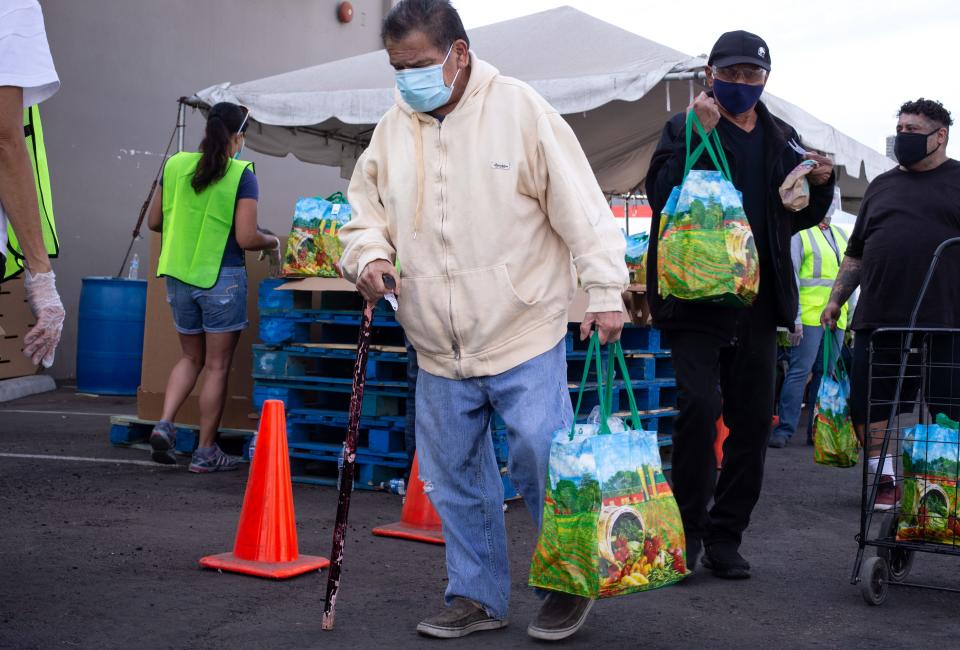12 truths of food waste and how to eat for the planet this holiday season

'Tis the season for sharing not too much.
Traditionally, end-of-year holiday feasts are a time of abundance. Thanksgiving celebrates the bounty of the harvest, and December's religious holidays are an opportunity to show gratitude for family and friends by rolling out a "Beauty and the Beast"-style presentation of fabulous food.
But as the conversation about the impact of food choices on the climate crisis picks up, one thing has become clear: People don't really like being told what to eat or not eat.
It's true that the climate impact of meat and dairy is greater than that of fruits, vegetables, nuts and grains. This discussion can include nearly endless detail and occupies the minds of many researchers worldwide.
Per 100 grams of protein, for example, beef production results in more than double the emission of planet-warming greenhouse gases as lamb, which is more than twice as damaging as pork, which is still worse than poultry. So, sticking with turkey as a meat option is a good place to start. Root vegetables and mashed potatoes are more sustainable than green beans or leafy vegetables. For dessert, food columnist Tamar Haspel recommends serving pies featuring food that grows on trees, such as apples, cherries or pecans, when trying to offer choices that limit global warming.
It gets more complicated when specific concerns like water conservation, land degradation or global hunger are prioritized. According to an analysis by Our World in Data, when local scarcity of water in the growing location is taken into account, nuts suddenly outpace cheese and even some beef as a climate culprit. But if limiting the carbon emissions caused by deforestation for agriculture is the central consideration, the impact of beef again dwarfs that of nuts. Results vary still more if the metric considered is total available kilocalories rather than grams of protein. And none of the above emphasizes the distance food must be transported from where it is produced to where it is consumed, its nutritional value based on factors like shade and soil quality, the amount of plastic packaging involved or justice issues related to farm working conditions.
Farmworkers face challenge:Climate change could push produce prices higher, slowing the fight for food justice
But though the climate crisis is human-caused and solutions must be human-led, our food traditions are highly sacred and staunchly defended: how and what we prepare for holiday meals, when and where we serve them, and to whom. For this reason, insisting that the path forward requires abstinence from certain cultural culinary joys may not be a fruitful way to mitigate warming.
A more palatable and arguably more effective message might be a reminder to just not prepare too much food this month.
Christopher Wharton, associate professor of Nutrition at Arizona State University's College of Health Solutions and a faculty coordinator with its Swette Center for Sustainable Food Systems, holds that reducing the amount of food that ends up in the landfill is the most important climate concept to keep in mind when planning celebratory menus.
“When you think about the holidays, it’s a time of greater expense and, probably, less healthy eating or more voluminous eating at least," Wharton said. "And it’s a time when we’re having more environmental impact because there might be more travel involved and, yes, there’s going to be more food waste."

The 12 truths of food waste
When it comes to talking about food waste, there's a lot to digest — a whole lot of data, but also many half-baked answers and leftover questions for which pinpointing numbers has been difficult.
Nevertheless, here are some facts about food waste from scientific research authorities, in the holiday spirit:
One billion people are malnourished even though the world currently produces enough food to feed twice the world's present population. (Source: Arizona State University)
We plate nearly two times the amount of food we eat. The rest ends up in the trash, wasting precious time and resources like farmland, labor, natural resources, water and transportation. (Source: Oregon State University)
If food loss and waste were its own country, it would be the world’s third-largest emitter, outdone only by China and the United States. (Source: World Resources Institute)
Food loss and waste generate more than four times the annual greenhouse gas emissions as aviation and is comparable to emissions from road transport. (Source: World Resources Institute)
In the U.S. one-fifth of food produced is wasted at the consumer level each year. Per person, that amounts to about 250 pounds of food waste per year and 775 kilocalories thrown out per day. (Source: Published study in the journal PLOS ONE)
Food waste is responsible for 6% of global greenhouse gas emissions. (Source: Our World in Data)
Americans could fill more than 700 college football stadiums with the food they waste each year. (Source: Arizona State University)
Annually, nearly 8% of all harvested cropland in the U.S. — more than 30 million acres — is used to grow food that doesn't get eaten. (Source: Published study in the journal PLOS ONE)
In a study of meat and poultry processing plants in 23 states, just over 9% of workers tested positive for COVID-19 during April and May 2020, leading to huge losses of meat from the supply chain. (Source: Published study in the journal Frontiers)
More than 10 million hens (plus potentially more than 10 million pigs) were estimated to have been culled (killed but not added to the food supply) because of COVID-19-related slaughterhouse shutdowns, many by methods animal welfare groups consider inhumane. (Source: Agribusiness analysts, as told to The Guardian)
System-wide, food waste is estimated at between 11% (at a minimum) and 60% depending on the commodity. (Source: Published study in the journal Frontiers)
On the United Nations' list of 17 sustainable development goals, the 12th global goal concerns the need to adopt more sustainable food production and consumption patterns to address climate change, reduce biodiversity loss and limit pollution. (Source: The United Nations Department of Economic and Social Affairs)
Be it leftover roast partridge or glazed pears gone cold, when the remains of holiday feasts get scraped into the trash and hauled to the dump, not only does it squander the resources used to produce and deliver it, but the rotting food also emits methane, a greenhouse gas with 25 times the warming effect of the carbon dioxide produced by burning fossil fuels.
Companies like the Phoenix-based Republic Services have recently invested in retrofitting landfills to capture and use that methane on-site as natural gas. But the better scenario for the climate would be if the food didn't end up there at all.
Rags to riches?How trash at landfills can be recycled into energy as flammable gas
Watch that waste
Fortunately, Wharton thinks that dealing with the problem of food waste is low-hanging climate solutions fruit.
"I really think food is a place where people have the greatest opportunity for huge impact on their own carbon footprint," he said. "Across the board with food behaviors, I think it makes sense to focus on food waste. A lot of people don’t often think about the climate issues that are embedded in food, so the amount of energy and water and other limited resources that are required to produce food is really meaningful."
Last year, Wharton published a study in the scientific journal Resources, Conservation and Recycling titled "Waste watchers: A food waste reduction intervention among households in Arizona."

With his collaborators, he recruited 53 households in Phoenix to participate in a five-week educational program on how to reduce food waste at home. Participants completed surveys on their food waste behaviors before and after the program and were trained on how to collect, weigh and report their weekly waste to Wharton's team.
The researchers found that exposure to information delivered via podcast, infographic and video resulted in an average reduction in food waste from each household by nearly 28%.
The education centered around the familiar principle of reduce, reuse and recycle and leaned on commonly shared values of environment, finances and health.
"Already, lots is going into planning and prepping big meals if you’re the one hosting," Wharton said. "But to the extent possible, if you can make it a collaborative effort, reaching out to people and then creating a menu in advance that’s designed around the food preferences of your guests as well as the number of guests you’re expecting, then you don’t need to design specifically for abundance."
Making tree rings sing: Making tree rings sing: Researchers find musical muse in forest climate data
So, planning a menu that is specific to the number of guests and their dietary needs rather than laying a table resplendent with every imaginable dish in the castle goes a long way toward reducing the amount of food going into the whole operation.
Opportunities to reuse require some advance planning and mostly come at the end of the meal but before the guests leave.
"Have reusable containers and send everybody away with portions of food so everybody gets to enjoy the leftovers and, hopefully, in meting out those leftovers you also reduce the amount that might get thrown out four or five days later. And the freezer is your friend when it comes to all sorts of things."

Finally, recycling food waste by placing it in either a home or municipal composting facility can make sure valuable and limited resources go right back into food creation. Gardening at home allows for easy reuse of this compost in fertilizing the next crop. And people who grow their own food or buy it locally directly from farmers are less likely to let those hard-won fruits and vegetables go to waste.
"It's easy to let a bunch of carrots just kind of wilt and go soft to the back of the fridge if they got it from Fry's," Wharton said. "But if they got it from farmer Frank at Crooked Sky Farms, they feel terrible, they really want to make use of it."
Read our climate series:The latest from Joan Meiners at azcentral, a column on climate change
As an additional holiday bonus, preparing appropriate amounts of food also has clear benefits for our waistlines and pocketbooks. Household food waste can add up to around $1,500 of grocery expenses per year, which can be a whole paycheck for many people, Wharton noted. At the national level, the U.S. Department of Agriculture estimated in 2014 that over $161 billion of food is wasted each year.
Wharton maintains a website with more information and tips on reducing food waste. In this week's interview, his final words of climate advice apply more to the cleanup and digestion aspects of holiday feasting:
"Switch to cloth napkins. The paper industry is another huge carbon emitter. If you can switch to the cloth version of things, it's really easy. They're just part of our laundry and no big deal," he said. "Then one day in the future we can talk about bidets. But not today."
Joan Meiners is the Climate News and Storytelling Reporter at The Arizona Republic and azcentral. Before becoming a journalist, she completed a doctorate in Ecology. Follow Joan on Twitter at @beecycles or email her at joan.meiners@arizonarepublic.com.
Support climate coverage and local journalism by subscribing to azcentral.com at this link.
This article originally appeared on Arizona Republic: Want climate-friendly holiday meals? Supersize impact by cooking less

